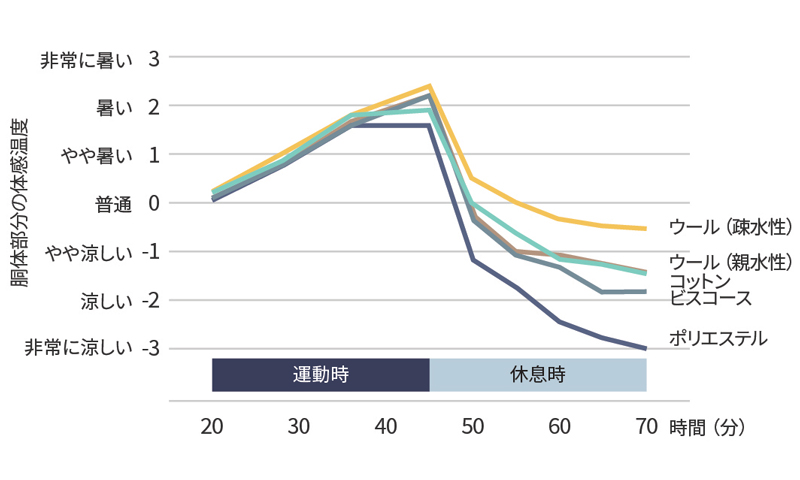新たな科学的研究から 、ハイキング、サイクリング、ロッククライミングなどアウトドアで「ストップ・アンド・ゴー(運動と休息)」を繰り返すスポーツにおいて、100%ウール製のベースレイヤーは運動時と休息時の両方で非常に高い熱的快適性を維持できることが実証されました。ウール独自の天然の構造によって繊維が体温の変化に反応し、アクティブな環境下でも着用者にとって最適な衣服内気候を維持します。

高強度の「ストップ・アンド・ゴー」スポーツにおいて、運動前後と運動中を通じてウール製ベースレイヤーが他繊維のベースレイヤーより快適であることは、最近まで主に経験則のみに基づく主張でした。しかしノースカロライナ州立大学で実施された4年間の博士課程研究によって、ウールの優れた熱的快適性は同様の厚さと重量の非ウール繊維生地と比べて、はるかに優れた 独自のメリットであることが実証されました。
「ストップ・アンド・ゴー(運動と休息)」スポーツにおいて、ウールがどのように発汗を管理するのか
ハイキング、サイクリング、ロッククライミングなどは、運動と休息を複数回繰り返すため「ストップ・アンド・ゴー (運動と休息)」スポーツとも呼ばれています。「ストップ・アンド・ゴー」スポーツのアスリートは、運動と休息を繰り返す中で運動中に汗をかきます。その汗は衣服に吸収され、休息中に衣服から放出されます。衣服から汗が蒸発する際には冷却効果が生まれ、この冷えがアスリートにとって不快な感覚を引き起こすことがあります。また冷えによる体温低下から回復するため、アスリートはより多くのエネルギーを費やすことになります。
この不快さを解決する方法は、安定した熱的快適性を維持できる衣服を選択することです。ウールは肌と生地の間に適度な空間 を作り出し、アスリートを寒さから守りつつ、ウール繊維の吸放湿性によって過剰な熱を段階的に放出することが可能です。こうした天然の温度調節機能のため、ウールは熱的快適性を維持する上で理想的な繊維と考えられます。
ウールには水分を吸収して発熱し、その後段階的に水分を放出する性質があります。またウールの疎水性の外層には、水分の急激な蒸発が引き起こす冷却効果を遅らせる特徴もあります。これら二つの機能が、ウールの優位性の根拠であると結論付けられました。

休息時のウールの優位性を研究が証明
本研究を通じて検査対象となった衣料品には、生地の重量と厚さが似通った、それぞれ100%のウール、コットン、ビスコース、ポリエステル素材の製品が含まれていました。研究の信頼性を検証するため、これらの生地は「発汗マネキン」、その後人体によって検査されました。
発汗マネキン検査では、相対湿度 (RH) が45%から80%へ移行する際、ウールは熱変化を緩和する性能が最も高いこと、またビスコース、コットン、ポリエステルよりもこの緩和効率が高いことが示されました。生地の吸放湿性と速乾性により、検査された他の生地と比較して、ウールは快適性と体感温度の維持に優れた天然の特徴を持つことが証明されました。
図1:ウール製品は休息時でも体感温度を適度に、より長く維持できることを示しています。
ノースカロライナ州立大学の研究者が実施したさらなる研究開発では、熱的快適性を測定する機器の改良も行われました。この機器はアウトドアウェアのデザイナーによって一般的に使用されていたものです。ハイキング、サイクリング、ロッククライミングなどの「ストップ・アンド・ゴー(運動と休息)」スポーツの最中、アスリートは気流や温度の変化のなかで競技を行っています。こうした動的な環境下での活動と休息の実態を、正確に反映させることを目的とした機器の改良です。
ウールを着用したアスリートは熱的快適性を維持することで、体温調節に必要なエネルギーを節約し、競技パフォーマンスにより多くのエネルギーを費やすことができます。アスリートへのこうした効能とパフォーマンスとの関連性を明らかにするため、現在も研究が進められています。
アクティブな吸放湿性を持つウール素材を調達
「ザ・ウール・ラボ」を通じて世界中のサプライヤーと繋がり、吸放湿性と快適性を追求したパフォーマンス・ウェアをデザインしませんか。様々な生地見本を検索して、ウールのアクティブな吸放湿性を活かしたベースレイヤー生地など、様々な素材を発見してください。

